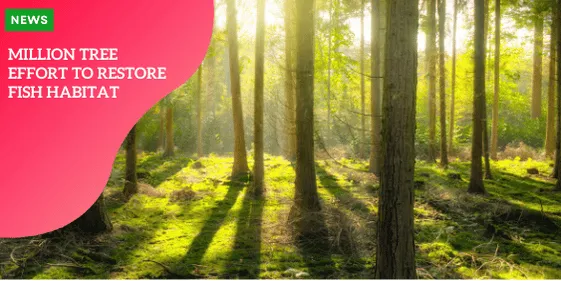Million Tree Effort to Restore Fish Habitat
By: Eduarda Moura Posted in: June 25, 2024 Last Update: May 9, 2025

Introduction to the Project
In a bid to rejuvenate wild fish populations, tens of thousands of native trees have been recently planted on the expansive Reay Forest Estate in Sutherland.
This ambitious reforestation initiative, known as the “Million Tree Project,” is part of a 10-year collaboration between the Atlantic Salmon Trust, a leading advocate for salmon conservation, and Grosvenor’s Reay Forest Estate, owned by the Duke of Westminster.
The project aims to restore critical habitats along the River Laxford, a vital waterway for Atlantic salmon and sea trout.
By planting a million native trees over the next decade, the initiative seeks to create a healthier and more sustainable ecosystem for these iconic fish species.
Importance of Reforestation for Fish Conservation
Trees play a multifaceted role in supporting aquatic ecosystems.
They help regulate river temperatures by providing shade, crucial for maintaining optimal conditions for fish.
Additionally, trees contribute to the ecosystem by offering habitats for insects that serve as food sources for fish, thereby bolstering the entire food chain.
Fallen leaves from these trees also enrich riverbeds with essential nutrients, further benefiting aquatic life.
Scale and Scope of the Planting Effort
The initial phase of the project has already seen the planting of over 70,000 trees across 198 acres (80 hectares) of land.
This marks just the beginning of an ambitious plan to plant up to one million trees in the region.
The chosen tree species include Aspen, Birch, Hawthorn, Holly, Oak, and Rowan, carefully selected for their ecological suitability and contribution to biodiversity.
Project Laxford: A Collaborative Conservation Endeavour
Known as Project Laxford, this comprehensive restoration initiative has garnered support from several key stakeholders.
The Scottish government’s directorate Marine Scotland and the West Sutherland Fisheries Trust are actively involved, underscoring the project’s significance in regional conservation efforts.
The Atlantic Salmon Trust, a prominent conservation charity, has highlighted the declining populations of salmon and trout in the Laxford and other Scottish rivers, making initiatives like Project Laxford all the more urgent.
Historical Context and Restoration Efforts
Grosvenor’s Reay Forest Estate boasts a rich history, but its management practices have undergone a significant transformation in recent decades.
Prior to the 1950s, the estate’s landscape likely reflected a more natural state.
However, in the mid-20th century, the focus shifted towards commercial forestry.
Non-native tree species were planted extensively, creating a managed forest that also provided employment opportunities for returning soldiers after World War II.
Recognizing the ecological importance of a healthy native ecosystem, the estate’s stewardship philosophy evolved over the past decade.
Efforts have focused on clearing these non-native species to make way for the reintroduction of native woodland varieties.
This shift in practices aligns with long-term conservation objectives and actively supports the return of indigenous biodiversity to the estate.
Project Laxford serves as a culmination of this commitment to environmental restoration, leveraging the power of reforestation to revitalize the River Laxford and its surrounding ecosystem.
Future Prospects and Environmental Resilience
Technical project manager Chris Conroy emphasized the critical nature of initiatives like Project Laxford amidst the challenges posed by climate change and habitat degradation.
With wild Atlantic salmon now classified as endangered in Britain, initiatives focusing on biodiversity enhancement and landscape resilience are pivotal.
Project Laxford serves as a model for such efforts.
By integrating climate-resilient strategies into reforestation efforts, such as those undertaken at Reay Forest Estate, the project aims to create a more robust ecosystem.
This includes selecting native tree species that can thrive in a changing climate and using planting techniques that promote healthy soil composition and water retention.
These combined efforts can create a more adaptable habitat, aiding species like salmon in weathering future environmental shifts and ensuring their long-term survival.
Conclusion: A Step Forward in Conservation
As the first river catchment-scale restoration project for the Atlantic Salmon Trust, Project Laxford sets a significant precedent in sustainable land management and biodiversity conservation.
Through strategic collaboration and proactive environmental stewardship, stakeholders aim to not only restore but also future-proof vital habitats for Scotland’s iconic fish species.
With continued support and innovation, initiatives like these pave the way for a more resilient and ecologically vibrant future.
By aligning conservation goals with sustainable land management practices, projects such as Project Laxford demonstrate a proactive approach to safeguarding biodiversity and enhancing ecosystem resilience in the face of ongoing environmental challenges.
Author
-

Eduarda Moura has a degree in Journalism from the Federal University of Minas Gerais and a postgraduate qualification in Digital Media. With experience as a copywriter, Eduarda is committed to researching and producing content for Life Progress Hub, providing readers with clear and accurate information.





